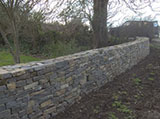
MENDIP FIELD BOUNDARIES (DRY STONE WALLS)
HABITAT ACTION PLAN
Action plan name
Mendip Field Boundaries (Dry Stone Walls)
Background and vision
Dry stone walls are a significant reason for the Mendip Hills’ national designation as an Area of Outstanding Natural Beauty. The 27 Sites of Special Scientific Interest and 2 National Nature Reserves in the AONB all feature dry stone walls as a major element. The walls are vital to the sense of place and character within Mendip District but also provide habitat to a variety of wildlife. They are also used as a navigation aid by colonies of Lesser Horseshoe Bats of European importance.
Dry stone walls are wildlife “rock gardens”. Lichens favour the exposed face in the pollution-free countryside. In damp and shaded areas feather and cushion mosses, algae and liverworts cover stones, creating tilth and compost for Stonecrop, Cranesbill, Ivy and ferns to gain a foothold. Drystone walls in limestone areas can support a rich snail fauna including national rarities such as Whorl Snails (Vertigo alpestrise).
In lowland Britain, the wall is often the surrogate natural scree or cliff and Wall pennywort and Rusty back Fern depend on such locations. A variety of ferns such as the polypodies, spleenworts and Wall Rue are common on dry stone walls.
Flora escapees from gardens are also prominent on stone walls, such as the ivyleaved toad flax, Oxford ragwort, Mind-Your-Own-Business and many members of the Stonecrop and Saxifrage (meaning rock-breaker) families.
As well as enclosing fields and providing shelter for farm animals, walls support a variety of life. Even a well-maintained dry stone wall is not without its holes, and nooks affording a variety of micro-climates for a multitude of insects and their eggs, spiders, woodlice, springtails, millipedes, bees and wasps. Toads, slowworms, voles, field-mice, shrews and hedgehog all find shelter among the leaffilled footings and fillings. Birds such as Wheatears may lay eggs if a low level gap is available, whereas Redstarts for instance prefer cavities higher up if woodland is close by. In open farmland a deep hole may house Little Owls. Horseshoe Bats use field boundaries such as walls to navigate across the countryside. There is even the possibility of including “letter box” cavities below the cope stone of higher walls for the benefit of bats, particularly Brown, Longeared and Natterers. Other improvements with wildlife in mind include holes to allow rabbits to pass and badger gates too could save much expense.
Semi-dereliction may have more opportunities for wildlife than a tightly-built wall since there are more sheltered spaces and more is covered in soil. However such a state is relatively short lived. Once reduced to less than half its height, a wall’s habitat value is considerably reduced. Thus walls need to be sympathetically maintained to provide varied habitats. Adding a little soil inside, splattering the face with manure and rebuilding walls with most of the past stone are a few ways of adding immediate natural value for wildlife.
In the Entry Level Environmental Stewardship scheme there are specific options available regarding stone walls. These include preventing deterioration, preferably as gaps appear, constructing walls in the traditional method with local materials, and leaving all stones in situ. In Mendip District the Mendip Hills AONB has funded the Life lines program specifically aimed at surveying and restoring the condition of stone walls, of which only a fraction remain stockproof.
Plan species and habitats
Bats use walls as navigation routes
Although elsewhere in the country walls are known to support a number of particularly rare species eg the Whorl Snails (Vertigo alpestris and Vertigo pusilla) and the Wall Mason Bee (Osmia parietina) there are no records of these species in Somerset.
Habitat status
All SSSIs (including the NNRs) in the Mendip District have dry stone walls.
Particular SACs in the area containing dry stone walls are also dedicated to bats such as the North Somerset and Mendip Bat SAC (Code: UK0030052).
Important for UK BAP species
Specific impacts/threats
· Deterioration of walls
· Biodiversity value of old walls can be lost when rebuilt.
Proposed partners
Mendip District Council (MDC)
Mendip Hills Area of Beauty (MAONB)
Natural England, particularly through ESS funding
Somerset Wildlife Trust including the Mendip Living Landscapes project
Somerset Environmental Records Centre (SERC)
Somerset Bat Group (SBG)
National Trust (NT)
Somerset County Council (SCC)
Farming and Wildlife Advisory Group (FWAG)
Current action
Mendip AONB’s lifelines project, funded by the Heritage Lottery Fund has enabled survey of the species found on Mendips Walls together with their condition.
Target description and goals
1. Promote the cultural and natural value of dry stone walls within the Mendip AONB
Goal: 1 public event per year focused on the culture of Mendip Hills AONB and traditional practice including dry stone walling
2. Improve knowledge of species use and range in relation to dry stone walls in Mendip District.
Goal: Full species lists for walls at 10 100m sites in separate 1km squares by 2009
3. Study mapped walls for use by other wildlife as corridors
Goal: Identify all walls within 500m of a known Horseshoe bat roost and survey around at least 1.
4. Produce guidelines for the current and future phases of wall restoration that include suggestions on how to improve the value of walls to wildlife
Goal: Guidelines available and given to all partners of Life lines by 2009
Key factors
Some additional funding is likely to be necessary.



